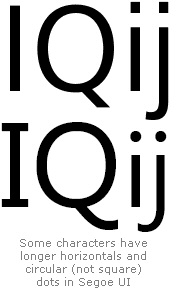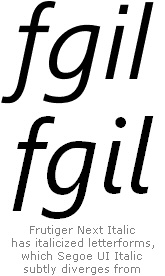A European agency has thrown out Microsoft's registration of the new font that's a trumpeted feature of the upcoming Windows Vista and Office 12. This calls into question whether the font is original or just a copy of someone else's -- with legal implications for Microsoft's much-delayed products.
Microsoft insists that Vista and Office won't be affected, and that the design of its new user-interface font is novel and fully licensed. Meanwhile, various bloggers who've heard about the decision have been throwing around terms like "blatant ripoff" to describe the case.
I believe the situation is a bit more complicated than that. Let's see what the fuss is all about and whether it'll impact Vista and Office.
The design of Frutiger Next and Segoe UI
Ordinarily, a new font would be no big deal. But Microsoft has tried to generate buzz about Office 12 and Vista -- both of which are now expected around January 2007 -- with major press relations on the new user interface of these two products, which are critical to the company's revenues.
"We're not just introducing a new UI in Office 12 -- we're also introducing a new UI font," writes Jensen Harris, a Microsoft program manager, in an MSDN blog about the redesign. "It was conceived, designed, and totally optimized for ClearType." ClearType is a technology that smooths fonts on LCD screens. It will be turned on by default for the first time in Vista. (It's also an option that you can enable by an obscure configuration setting in Windows XP.)
 The rap against Microsoft, at least as determined by Europe's trademark and design office, is that the Redmond company's new font is similar to Frutiger Next, a design by Linotype, the famous German type firm. Microsoft applied for at least eight design registrations in January 2004 for different weights of Segoe UI, its user interface font. These registrations were appealed by Linotype's parent, Heidelberger Druckmaschinen (which roughly translates as "Heidelberg Printing Presses").
The rap against Microsoft, at least as determined by Europe's trademark and design office, is that the Redmond company's new font is similar to Frutiger Next, a design by Linotype, the famous German type firm. Microsoft applied for at least eight design registrations in January 2004 for different weights of Segoe UI, its user interface font. These registrations were appealed by Linotype's parent, Heidelberger Druckmaschinen (which roughly translates as "Heidelberg Printing Presses").
The EU's Designs Department declared all of Microsoft's registrations invalid, saying Segoe's letterforms "differ only in minor details" from Frutiger. The three judges in the case noted that Microsoft disputed the documentation of Druckmaschinen's fonts but "does not contest the claim of the Applicant that they should be considered identical."
To investigate this, I purchased a copy of the Frutiger font from Linotype.com and compared it with the version of Segoe (pronouced "see go") in the latest beta of Windows Vista. As you can see from the image at left, the two fonts are remarkably similar, differing in subtle ways that are apparent only when the fonts are blown up to enormous sizes.
This doesn't necessarily mean that Segoe can't be used in Vista and Office 12, however. Under the copyright laws of the U.S. and some other countries, the visual design of a typeface cannot be protected. Only the name of a font can be protected under separate trademark rules. This quirk of the law has allowed hucksters over the years to sell exact copies of many well-known type designs, with only the name changed from the original.
Recent court decisions have given some additional protection to the code of computer fonts (as opposed to their design). For details on this confusing situation, see the explanation at SIL International, a nonprofit translation organization.
In my character-by-character analysis of Frutiger Next and Segoe UI, it can be seen that the new Vista/Office font is not a byte-by-byte copy. For example, the tips of the "f" and "g" in the image shown above are a little more acute in Segoe than in Frutiger Next.
Microsoft told me in an e-mail from a public relations spokesman (who asked not to be named, in accordance with company policy):
"We respectfully disagree with the decision by the European Union's Office of Harmonization in the Internal Market (OHIM) to nullify Microsoft's registered community designs for various fonts in the expanded Segoe family. Contrary to OHIM's assertions, none of the subject fonts were derived or based on the Frutiger family of typefaces. Clear differences exist between the subject fonts in the expanded Segoe family and those cited to OHIM as prior art. Microsoft is within its rights to use various fonts from the Segoe family for the branding, packaging, and UI for products including Windows Vista, regardless of OHIM's decisions."
The argument that Segoe differs from Linotype's designs has also been made publicly by Simon Daniels, lead fonts program manager for Microsoft Typography. In an MSDN blog, he writes:
"Unlike Verdana and Frutiger, the typeface [Segoe UI] has a lively true italic, not based on an obliqued or slanted regular style. Also unlike the humanist sans faces designed primarily for print-use the fonts include distinctive letter shapes that help the user distinguish between easily confused characters like lowercase l and uppercase I."
 Segoe clearly differs from Frutiger in its treatment of the uppercase I and a few other letters. The image at left shows the four characters that have easily discernible differences in the two fonts.
Segoe clearly differs from Frutiger in its treatment of the uppercase I and a few other letters. The image at left shows the four characters that have easily discernible differences in the two fonts.
The uppercase I and Q in Segoe have horizontal strokes that make them look less like a lowercase l and an uppercase O. In addition, the lowercase i and j characters in Segoe have been given round dots instead as square, as in Frutiger Next.
The claim that Segoe Italic is a lot different from Frutiger Next Italic, however, isn't very strong.
It's apparent that Frutiger Light Italic, designed by Adrian Frutiger in 1976, obliquely slants its characters instead of having true italics. But 7 out of the 8 decisions handed down by the EU's Designs Dept. invalidated Microsoft's registrations because of Segoe's similarity to various weights of Frutiger Next, which was released in 2000. (The EU has posted PDF files of the decisions, numbered 1, 2, 3, 4, 5, 6, 7, and 8.)
The "fgil" image, below, shows the only four characters I found in Frutiger Next Italic and Segoe Italic that differ in significant ways. Other than the tails at the bottoms of the f, i, and l characters, the differences are almost impossible to notice at normal font sizes.
When Microsoft says Segoe UI isn't based on Frutiger, you can't just compare Segoe with the old Frutiger Light. You must match it up against Frutiger Next, which was redesigned by Adrian Frutiger specifically for computer displays.
How wrong is it to copy software, really?
All of this may seem like a tempest in a teapot to people who don't follow the software industry. But the question of whether Microsoft's much-vaunted new user interface font was copied from someone else's design is critical in a number of ways.
 It may or may not be illegal in the U.S. to copy a font design. But it's also not illegal under some interpretations of China's laws to make unlimited copies of Microsoft software. Microsoft has complained loudly about this -- but if the Redmond company were to be caught copying font designs instead of paying to license them, it could seriously weaken the software giant's argument.
It may or may not be illegal in the U.S. to copy a font design. But it's also not illegal under some interpretations of China's laws to make unlimited copies of Microsoft software. Microsoft has complained loudly about this -- but if the Redmond company were to be caught copying font designs instead of paying to license them, it could seriously weaken the software giant's argument.
Microsoft clearly maintains that its new fonts have honorable beginnings. In his blog entry, Daniels described the fonts' genesis this way: "The original Segoe fonts were not created for or by Microsoft. It was an existing Monotype design which we licensed and extensively extended and customized to meet the requirements of different processes, apps and devices."
Microsoft's p.r. spokesperson made the same point in a second e-mail that was sent to me, saying:
"Segoe was an original design developed by Agfa Monotype (now Monotype Imaging) in 2000. In 2003, we acquired the original Segoe fonts and used them to develop an extended family of fonts retaining the Segoe name. Many of these new fonts received design patent protection in the United States. Segoe was not derived from Frutiger. Microsoft also has a current up-to-date license that allows us to distribute certain Frutiger fonts in connection with Microsoft products including Office and Windows. There are distinct differences between Segoe and Frutiger. Additionally, unlike clone typefaces, the Segoe family of fonts are not metrically compatible with Frutiger so cannot be used as replacements."
Microsoft is putting a lot of emphasis on Monotype as the original source of the Segoe UI fonts. But what does Monotype itself have to say about the controversy?
I'll dig into that next week.

